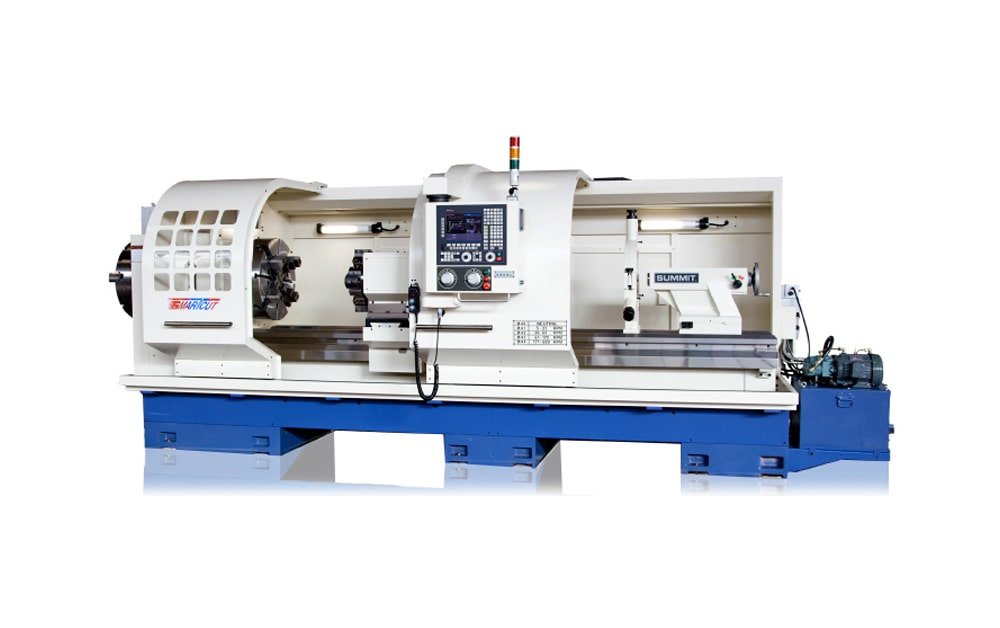Computer Numerical Control (CNC) metal lathes represent a fundamental class of machine tools that have revolutionized the production of cylindrical and rotational parts across industries. These automated turning centers combine traditional lathe functionality with computerized control to achieve levels of precision, repeatability, and productivity unattainable with manual machines.
Core Components and Specifications
A standard CNC metal lathe consists of several critical subsystems:
- Headstock Assembly
- Contains the main spindle (typically 40-200 mm bore diameter)
- Powered by AC servo motors (5-100 HP range)
- Provides rotational speeds from 50-4,500 RPM (high-speed models reach 10,000+ RPM)
- Incorporates hydraulic or pneumatic chucking systems (3-jaw chucks most common)
- Bed and Guideways
- Manufactured from Meehanite cast iron (Class 40-50) for vibration damping
- Hardened and ground linear guideways (0.01 mm/m straightness tolerance)
- Bed lengths range from 500 mm (bench-top) to 6,000+ mm (oilfield applications)
- Tool Turret
- Holds 8-24 cutting tools in ISO-standard holders
- Indexing time: 0.2-0.8 seconds between tools
- Live tooling options enable milling/drilling operations
- Control System
- Industry-standard Fanuc, Siemens, or Mitsubishi controls
- Minimum programmable increment: 0.001 mm (0.0001″)
- Typical memory capacity: 1-4 MB for complex programs
 Technical Capabilities
Technical Capabilities
Modern CNC metal lathes demonstrate impressive performance metrics:
- Turning Diameter Capacity:
- Standard models: 300-800 mm swing
- Large-capacity: Up to 2,500 mm for energy sector components
- Dimensional Accuracy:
- Standard tolerance: ±0.025 mm (±0.001″)
- High-precision models: ±0.005 mm (±0.0002″)
- Surface Finish:
- Routine production: 1.6-3.2 μm Ra
- Fine finishing: 0.4-0.8 μm Ra with proper tooling
Material Processing Characteristics
CNC lathes efficiently machine all common engineering metals:
| Material | Cutting Speed (m/min) | Feed Rate (mm/rev) | Depth of Cut (mm) |
|---|---|---|---|
| Aluminum 6061 | 200-500 | 0.1-0.3 | 2-6 |
| Mild Steel | 100-250 | 0.08-0.2 | 1.5-4 |
| Stainless 304 | 50-120 | 0.05-0.15 | 1-3 |
| Titanium | 30-80 | 0.04-0.1 | 0.5-2 |
Economic and Operational Factors
The manufacturing industry has documented several key performance indicators for CNC lathe operations:
- Setup Time Reduction: CNC automation reduces changeover time by 60-80% compared to manual lathes
- Tool Life: Modern carbide inserts last 15-45 minutes of cutting time in steel
- Energy Consumption: 10-30 kW typical during cutting operations
- Operator Requirements: 1 technician can typically oversee 2-4 machines
Industry Applications
CNC metal lathes serve critical roles across multiple sectors:
- Automotive
- Production of shafts, bushings, and pulleys
- Typical batch sizes: 500-50,000 pieces
- Aerospace
- Machining of landing gear components
- Titanium turning with specialized coolant systems
- Medical
- Precision surgical instrument components
- Micro-turning capabilities down to 0.1 mm diameters
- Oil and Gas
- Large-diameter valve bodies and fittings
- Specialized threading for pipe connections
Technological Advancements
Recent developments in CNC lathe technology include:
- Multi-Tasking Machines: Combining turning and milling in single setups
- Automated Loading: Robotic integration for lights-out production
- Smart Monitoring: Vibration sensors and tool wear detection systems
- Energy Recovery: Regenerative braking systems for servo motors
Maintenance Requirements
Proper upkeep ensures optimal machine performance:
- Daily: Chip removal and way lubrication checks
- Monthly: Ball screw and bearing inspection
- Annual: Spindle runout verification (should be <0.005 mm)
- 5-Year: Complete guideway rescraping/replacement
CNC metal lathes continue to evolve, with current research focusing on:
- AI-assisted tool wear prediction
- Hybrid additive/subtractive manufacturing cells
- Enhanced thermal compensation systems
This technology remains indispensable for precision metalworking, combining decades of mechanical refinement with cutting-edge digital control to meet the demanding requirements of modern manufacturing.







